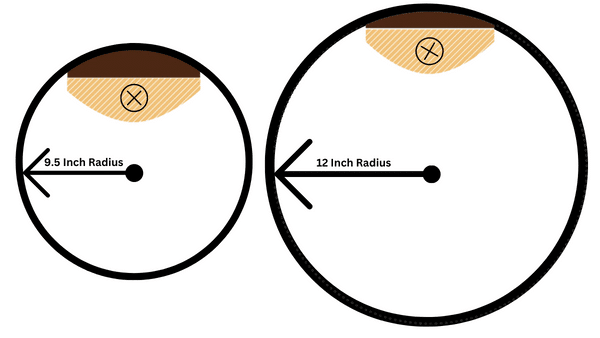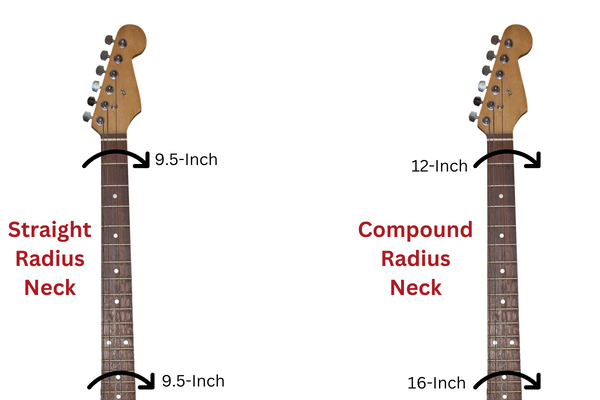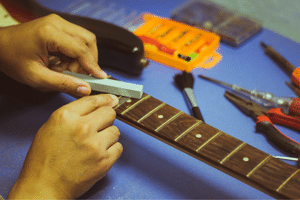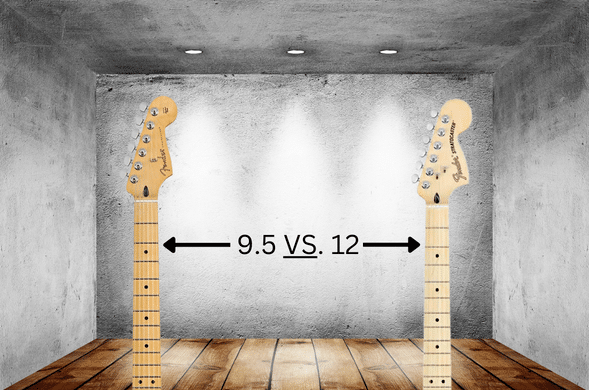The neck of a guitar virtually defines the instrument’s playability! Beginning and advanced guitar players often struggle to find their dream guitar with that “perfect neck.” In this article, I’ll reveal the difference between a 9.5 VS 12 inch fingerboard radius and which one might be best for you.
Keep on reading to learn more!
You can use the table of contents below to take you to the area that interests you. Click on the little box to open it, and then click on the section of the article you want to read, or you can read from start to finish if you want the full fingerboard radius experience!
The Short Answer
Neither fingerboard radius is clearly better than the other. A 9.5-inch fingerboard radius is more comfortable for chording notes, while a 12-inch radius fingerboard makes bending notes, vibrato, and tapping easier. You should choose the radius that feels most natural and works best for the style of music you play. Play as many different guitar makes and models as possible until you find the one that is right for you!
Keep On Reading (Below) To Learn More
What Is Fingerboard Radius?
First, you need to understand how fingerboard radius (also called fretboard radius) is measured and why it matters.
Here is an image that illustrates the principle, comparing a 9.5 to a 12-inch fingerboard radius neck.

As you can see, the amount of each fingerboard curvature is determined by the circumference of that circle’s radius, where the mid-point is lined up to the center of the neck. That’s really all there is to it!
So, the bigger the fingerboard radius, the flatter the fingerboard, and vice-versa!
Therefore, the 9.5-inch fingerboard radius would be more curved than the 12-inch fingerboard illustrated above.
Now that we’ve gotten that out of the way, we can get on to the practical stuff!
Guitar Model Fingerboard Radius Comparison
To better understand what I’m talking about, check out this table that shows guitar models with a fingerboard radius of 9.5-inch and 12-inch plus a compound radius (explained in the next section).
| 9.5-Inch Fingerboard Radius | 12-Inch Fingerboard Radius | Compound Fingerboard Radius |
|---|---|---|
| Fender American Performer Series | Fender Deluxe Series | Fender American Ultra Series |
| Fender American Professional II Series | Fender Stories Collection Eric Johnson 1954 | Jackson American Soloist SL3 Series |
| Fender Vintera Modified Series | Gibson Les Paul Series | Charvel Signature Pro-Mod San Dimas Series |
| Fender Original ’60s Jaguar | Gibson SG Series | Schecter Banshee Mach 6 & 7 Series |
The vintage fender guitars have a very curved (7.25-inch)fingerboard radius, while many of the newer Fender models have a flatter (9.5 or 12-inch) radius.
Gibson guitars generally have a 12-inch fingerboard radius.
Some of the guitars made for picking and tapping fast solos have an ever flatter fingerboard (15-inch or greater) or a compound radius fingerboard.
What Is A Compound Radius Neck?
Although necks with compound radius fingerboards are not the main subject of this article, I thought I’d give a brief explanation since you’re likely to come across it in your reading. You may skip this section if you wish.
Here is a diagram that shows the difference between a regular (straight radius) fingerboard and a compound radius fingerboard.

As you can see, a straight radius fingerboard has the same curvature all over the neck.
A “compound” radius neck fingerboard starts off more curved at the nut and progressively flattens out all the way down to the other end. This design can give you the best of both worlds.
The smaller radius areas of a compound neck make chord playing more comfortable, while the larger radius areas make it easier to bend strings.
Compound radius necks are great for guitarists that play rhythm and lead guitar. The downside is that they make the guitar more expensive. However, once you play one, you will probably want to take that baby home!
So, if you’re the lead guitar player in a high-octane Rock or Metal band, you should probably go with a 12-inch or larger straight radius neck or look into the compound radius option.
In the following sections, I’ll take you through some of the things you need to be aware of when deciding if a 9,5 or 12-inch fingerboard radius is best for you.
How Does Fingerboard Radius Affect Playability?
Fingerboard radius can affect playability in three main ways (we’ve already covered the first two).
- Smaller radius (more curved) fingerboards are generally more comfortable to play chords on, especially in the lower frets
- Larger radius (flatter) fingerboards usually are easier to bend notes on, especially on the lower frets
- It can affect a guitar’s string height (action), which is discussed in the section below
Is A Flatter Fingerboard Always Better?
Not really. Each player can find a different fingerboard radius more comfortable. It depends on things like the size of your hands, the guitar, how much rhythm vs. lead guitar you play, and the genre of music.
For example, Metal players prefer a flatter fingerboard with jumbo-size frets, and most guitars designed to play Metal have a fingerboard radius of 12-inches or larger.
Players that prefer a more “Vintage” feel may like a 7.25-inch fingerboard radius with vintage-size frets, whereas a 9.5-inch fingerboard with medium-jumbo frets will give a more modern feel.
It all depends on what plays and sounds best to you!
Does Fingerboard Radius Affect String Height?
Yes, the fingerboard radius can be a factor in determining a neck’s action (string height), which is the distance from the top of the frets to the bottom of the strings on all areas of the fingerboard.
Neck action (string height) can generally be set lower on a larger radius fingerboard without fret buzz or “fret out,” especially during string bending.
If you want a guitar with a fast-action neck for playing high-speed riffs and note tapping, you’re probably better off with a flatter (larger radius) fingerboard.
So, If you need a great all-around guitar that’s comfortable when playing any musical genre, the 9.5-inch fingerboard will probably be your best bet.
If you want to rip some fast solos, you’re better off with the lower action and a 12-inch radius (or larger) fingerboard.
Does Fingerboard Radius Effect Tone?
No, not typically. Most players who notice a change in tone when playing a guitar with a different fingerboard radius than they are used to need to adjust their playing technique.
However, it’s true that theoretically, a very big neck could change the tone and sustain of a guitar because it resonates more. These necks tend to have a richer and more balanced tone with more sustain.
You can’t play a Strat with a 9.25-inch fingerboard radius with the same touch required for a Les Paul with a 12-inch radius. To quickly switch back and forth between the two guitars with a good tone, you must practice enough to get comfortable with the feel of both instruments!
It is possible that a guitar that is not set up correctly could cause an issue with tuning, intonation, or fret buzz, but this is different than tone.
What About Fret Size?
Fret size usually goes hand-in-hand with fingerboard radius, although you can pair the two any way you like.
The first Fender guitars with the very curved 7.25-inch radius fingerboards had small (narrow-short) frets. That fret size gave the neck a naturally comfortable feel. However, these days, you can get that fingerboard radius with bigger frets to make bending easier.
Guitars with a fingerboard radius in the 9.5-inch range pair better with narrow-tall or medium-jumbo frets, giving you the best compromise between playing chords and soloing.
Moving up to the 12-inch and higher fingerboard radius, jumbo frets tend to work best to make it easier to bend strings with a lower-action setting.
However, there are a few tradeoffs with various fret heights. Shorter (lower) fret sizes are harder to accidentally make a note sharp by pushing down too hard but require more fretting pressure. Taller (higher) fret sizes are the opposite. They need less fretting pressure but are easier to sharpen a note by pressing too hard.
So, players who like to press hard are usually more comfortable with low frets and curvy necks, while shredders want to fly across the fingerboard with tall frets and flat necks.
Therefore, if you don’t choose an average fret height, like a medium-tall (semi-jumbo), you may need to adjust to a heavier or lighter fingerboard touch that may feel unnatural or uncomfortable.
Why Guitar Neck Shape And Size Matters!
The fingerboard radius and fret size are not the only things that can determine a guitar neck’s sound and playability. The neck’s profile, depth, and width are other things that should be taken into consideration. Each one of these three neck characteristics is independent of the other two.
Neck Profile
This represents the shape of the neck as viewed in cross-section. Over the years, these profiles have been commonly called V, C, D, and U, based on their resemblance to these letters of the alphabet. The “V” and “C” profiles are more comfortable for small hands, while players with larger hands usually prefer the “D” and “U” profiles.
There are also “in-between” profiles, such as the oval C-shape, which is one of the most comfortable necks to play unless you have large hands.
Neck Depth
A neck’s depth refers to the thickness of the neck as measured from the middle of the bottom of the fingerboard to the back of the neck. One-piece maple necks are measured from the top of the middle of the fingerboard to the back of the neck. Players with small hands typically prefer less deep necks and vice-versa.
A deep neck with a D or U profile may have more wood, which could give it a richer tone with increased sustain.
Neck Width
The width of a neck is measured at the nut, from one end to the other, and is sometimes referred to as the “nut” width. This is the narrowest part of the neck, which progressively widens as it approaches the guitar’s body.
Narrower neck widths give you tighter string spacing and vice-versa. Players with wide fingers may prefer a wider neck width.
Pros And Cons Of A Guitar Neck’s Specifications


This table should help you see the bigger picture when selecting a guitar neck. As you can see, it’s not just the fingerboard radius that matters!
| Consideration | Pros | Cons |
|---|---|---|
| Smaller Radius | More Comfortable to Play Chords | More Difficult to Bend Strings |
| Larger Radius | Easier to Bend Strings | Less Comfortable to Play Chords |
| Compound Radius | Best for Chords and Bending | Adds Cost to the Guitar |
| Smaller Fret Size | Harder to “Push” Note Sharp | Requires More Fretting Pressure |
| Larger Fret Size | Requires Less Fretting Pressure | Easier to “Push” Note Sharp |
| Neck Profile | “V, C, & Oval-C” ok for Small Hands | “D and U” worse for Small Hands |
| Smaller Neck Depth | Easier to Play with Small Hands | Can Have Less Tone and Sustain |
| Larger Neck Depth | Can Have Better Tone and Sustain | Harder to Play with Small Hands |
| Smaller Neck Width | Closer String Spacing | Harder to Play with Fat Fingers |
| Larger Neck Width | Easier to Play with Fat Fingers | Wider String Spacing |
Can You Change The Neck On Your Guitar?
Yes, you can change the neck on some guitars, but there are some limitations you need to be aware of.
The most important thing to remember is that the scale length of the original and the replacement neck must be the same! For example, you can’t put a 24+3⁄4 inch neck on a guitar that has a 25+½ inch neck.It won’t sound right because the intonation will be off.
Neck changes can be done relatively easily with bolt-on-neck guitars.
Swapping a glued-in neck is hardly ever done unless the original neck is damaged beyond repair. It requires a luthier (guitar builder) to do it right and is usually cost-prohibitive.
Neck-through-the-body guitars cannot be changed-out because the body is glued onto both sides of the neck.
Players usually change out a neck to have one with a different fingerboard radius and fret size. If the radius is ok, you may be able to keep the neck and replace the frets with smaller or larger ones.
If you are going for a re-fret, oftentimes, the fingerboard can be reshaped to change the radius.
It can be cheaper to buy a replacement neck than to make fingerboard and fret modifications.
You could permanently damage your guitar during a neck modification if you do not have the proper tools or training. Take the guitar to a certified technician or luthier!
Are You Qualified To Make Guitar Adjustments Or Modifications?

It’s great to work on your guitars, especially if you have a lot of them, but you should always be aware of your limitations.
Adjusting things like an electric guitar’s string height (action) or pickup height can be straightforward. Still, some adjustments require the proper training and experience, like doing work on your guitar’s neck or adjusting its truss rod.
When you doubt your ability to adjust, repair, or modify your guitar, it’s always best to bring it to a competent guitar technician or luthier (guitar designer & builder). You can permanently damage your guitar, and it might never play and sound right again!
Making modifications to your guitar can void its manufacturer’s warranty and cause permanent damage to the instrument. Certain modifications are irreversible, so you may be stuck with them, even if you desperately want to restore the guitar to its original condition!
I learned that the hard way over the years until I did a three-year apprenticeship in a guitar repair shop. Now I have my own home workshop with the proper training and equipment to safely maintain and repair all my instruments.
Remember: “When In Doubt, Send It Out!”
Frequently Asked Questions

Here are some of the questions I get asked about guitar necks and fingerboard radius.
If your question does not appear here, please put it in the comments, and I will get right back to you with an answer.
Are Fat Neck Guitars Easier To Play?
Not necessarily. It depends on things like the guitar design, your playing style, and your hand size. Players with big hands usually find a fat neck more comfortable to play, but not always. It’s essential to play guitars with various neck sizes to find the one that is right for you!
What Fretboard Radius Does John Mayer Use?
The John Mayer PRS Signature Silver Sky has a vintage-style 7.25-inch fingerboard radius. The – PRS SE Silver Sky has a more modern-style 8.5-inch fingerboard radius.
Should A Guitar Neck Be Straight Or Curved?
Ideally, a guitar neck should be as straight as possible. Still, each neck must be adjusted to have the minimum amount of curve needed to eliminate string buzz and intonation issues.
Why Are 6105 Frets So Popular?
These frets are tall and narrow, so they are great for string bending with a more “vintage” feel. They are a favorite among Blues and Jazz-Fusion players.
Why Do People Like Jumbo Frets?
Jumbo frets can make it easier to bend strings, especially on a neck with a more curved fingerboard. The frets are wider and taller, allowing the guitar to be easier to play when set up with a lower action.
Are Jumbo Frets Good For Beginners?
Jumbo frets are ok for beginners, but small or medium-jumbo frets make chording more comfortable and usually easier to slide up and down the strings. Jumbo frets are better for more advanced payers that do string-bending and vibrato.
Final Thoughts

I hope you enjoyed this article on the differences between a 9.5 VS 12 Inch fingerboard radius and that you found it helpful in choosing your first or next guitar!
When it comes to fingerboard radius, neither 9.5 nor 12-inch is clearly better. It depends on your guitar design, playing style, music genre, and hand size.
Fingerboard radius can affect the feel and playability of a neck in several important ways.
Generally speaking, a 9.5-inch fingerboard has more of an “all-around” feel, making chording notes comfortable and accommodating string bending.
Players who are more interested in speed, note bending, vibrato, and tapping will probably do better with a 12-inch fingerboard radius neck.
A larger fingerboard radius can usually accommodate a lower action (string height).
Fingerboard radius has minimal, if any, effect on tone. Very big (thick) necks can improve tone and sustain.
The best way to find the ideal fingerboard radius is to play as many different guitar makes and models as possible. For example, fender guitars can play very differently than Gibson or Ibanez models.
Other Factors To Consider
Compound radius necks can offer the best playing comfort, note chording, and sting bending. They are more challenging to manufacture than a straight radius neck and may significantly increase the price of a guitar.
The shape of a guitar neck works together with the fingerboard radius and fret size to define its playability.
A guitar with a bolt-on neck can usually be swapped out for a neck with the same scale length. Do not attempt this if you don’t have the proper tools and training.
Have A Look At This Video
Here’s a great video from the Fender Custom Shop, where master builder Dennis Galuszka talks about neck radius and how it can affect different playing styles. Check it out. It summarizes a lot of the info I talked about!
Related Article ➡ 7.25 VS 9.5 Inch Fingerboard Radius – Which Is One Is Better?
Related Article ➡ When To Buy Your Second Guitar? (With Buyer’s Guide).
Related Article ➡ Do Strats Have A Compound Radius? – What You Should Know!
Tell Me What You Think

Please leave a comment below if you enjoyed this article, have any questions about fingerboard radius, or want to give your point of view. I will be happy to help you.
- What fingerboard radius do you prefer? Why?
- Which guitar do you think has the best neck overall?
- Do you favor playing a single guitar or having others with different necks?
- After reading this article, do you know which fingerboard radius is best for you?
- What else is on your mind?



Ah, thank you so much for the graphics to illustrate where the radius measurement comes into play. The curvature on the neck doesn’t always look obvious, so I wasn’t sure what the radius number meant. It’s interesting to note that some are straight while others are compound. This is going to help me dial in exactly what it is that I like about my favorite guitars. Thank you!
Hi, Aly
The main advantage of a compound radius fingerboard is that it is more curved near the nut for comfort when chording notes and flattens out as you go up the neck for playing solos.
If I remember correctly, you play bass guitar, so you’ll probably want a fingerboard radius in the flatter range all the way up the neck.
Keep On Playin’ 🤘
Frank 🎸
I am not the guitar player of the household, but my boyfriend is, and he knew everything your article speaks of with the radius’, where I was so clueless.
I had bought him a guitar online for Christmas about 2 years ago now, I only went off what he had been playing and what he said he wanted from a guitar. Luckily for me, I paid very close attention to what he was saying, but unbeknownst to me was the fact that I had purchased the compound radius neck. After reading your article, I now know why he was so happy with his guitar, he is currently sitting on his stool picking away and grinning ear to ear.
While I am not shopping today, it was great to read your article and discover that I can accidentally buy better quality and not really know it lol. I do try to ask him before I purchase, but on gifts, it’s hard to be clever all the time.
I am bookmarking your page for future shopping, however. Having expert guidance is nice.
Stacie
Hi, Stacie
Thank You for your comments!
Yes, buying just the right guitar can be challenging! There are so many different types and models to choose from!
I’m so happy that worked out well for him.
Generally speaking, most guitars with a compound radius fingerboard are in the higher quality range, so I’m betting he got a really nice instrument!
Stay Well,
Frank 🎸
My big (looks like a pre-war Emperior) archtop uses the largest gauge strings I can find and it has a compound radius. People comment on how easy it is to play. I have a cheap-o Strat copy. I have set it up about as well as can be expected. Not at all easy to play. I could pull the frets, compound radius the neck, re-fret… (ad infinititum….). In the end I would have a lot of hours into a semi-easy to play, $80 Strat copy.
Hi, Max
I agree.
Those pre-war Epiphone Emperor archtop guitars are great players! ?
Frank ?